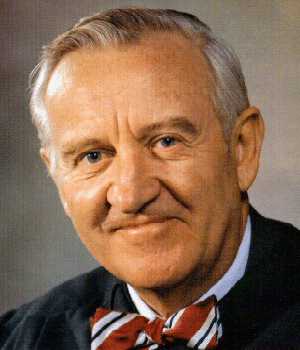The Betamax Case
At the beginning of the trial, five justices  (Justices Brennan, Marshall, Powell, Rehnquist, and White) voted to deny certiorari, or not to let the case come to trial. In fact, after the first arguments, the oral opinion was to agree with Ninth Circuit's decision. The majority opinion was given to be written by Justice Blackmun and the minority opinion by Justice Stevens. Stevens however was not ready to give in and tried to sway the argument towards the Sony Corporation. His argument stated that copyright laws did not include single copies of copyrighted material used for non-commercial purposes. In a memo to Justice Blackmun, Justice Stevens outlined his argument into three major reasons to reverse the decision:
(Justices Brennan, Marshall, Powell, Rehnquist, and White) voted to deny certiorari, or not to let the case come to trial. In fact, after the first arguments, the oral opinion was to agree with Ninth Circuit's decision. The majority opinion was given to be written by Justice Blackmun and the minority opinion by Justice Stevens. Stevens however was not ready to give in and tried to sway the argument towards the Sony Corporation. His argument stated that copyright laws did not include single copies of copyrighted material used for non-commercial purposes. In a memo to Justice Blackmun, Justice Stevens outlined his argument into three major reasons to reverse the decision:
"(1) the privacy interests implicated whenever the law seeks to control conduct within the home;
(2) the principle of fair warning that should counsel hesitation in branding literally millions of persons as lawbreakers; and
(3) the economic interest in not imposing a substantial retroactive penalty on an entrepreneur who has successfully developed and marketed a new and useful product, particularly when the evidence as found by the District Court indicates that the copyright holders have not yet suffered any harm." (From www.hrrc.org/courtmem.html)
Justice Stevens was a natural choice to take on the Betamax case. Throughout his career, Stevens had studied anti-trust laws. In 1951 Stevens headed a government study on anti-trust laws, and continued to research the legal case as Attorney General in 1953 - 1955. Although the Betamax case seems to be a copyright infringement case, it's decision would have a great effect on exhibition of Hollywood films. Before 1949's Paramount case, the major film companies legally could own the production, the distribution, and the exhibition companies. This vertical monopoly allowed forced theaters to play their production company's films. If the Betamax case were to lose, then royalties would have to be paid to the production companies and, therefore, not only would they receive monetary funds from the VCR industry, but they also could have some control of the exhibition. Stevens, however, seeing this trend towards giant monopolies, decided to fight the lower court's decision.
Justice Stevens' dissent seemed to have some effect when both Justices Brennan and White decided to back Justice Stevens. Also, Justice O'Connor wanted to send the case back to the Ninth Court to see if in fact the film studios had suffered any economic harm from the VCR industry. She argued to Justice Blackmun that new clauses should be included in the opinion that stated some uses of the VCR did not indeed violate copyright laws. By the end of the term, the Justices had not reached a clear-cut decision, so the case was held over to the new term.
In October 1983 a second oral argument occurred where six Justices voted to overturn the earlier decision (Justices Brennan, Burger, O'Connor, Powell, Stevens, and White) with three dissenting (Justices Blackmun, Marshall, and Rehnquist). The final vote was cast in January 1984, a year after it was first introduced, and Justice Powell decided to vote against Sony making the final decision 5-4 in favor of Sony.
This decision occurred in a time period where the communications industry was being broken down in order create a cheaper products for the consumer. The same month that the Betamax case occurred, the Supreme Court decided to breakup the telephone giant AT&T by awarding MCI a huge sum of 1.8 billion dollars in damages. This idea of cheaper consumer goods was predominate in President Reagan's economy. Telephone calls became cheaper and VCR prices remained fixed, but both would have risen without the Supreme Court's decisions.
By legalizing the VCR, their sales jumped from 7.6 million units in 1983 to 17.7 million in 1984. (Gertner p.10A) The film companies, however, did not completely lose out, since a new videocassette market started to emerge and thrive economically. Videocassettes of films now could be rented from local stores and companies such as Blockbuster moved into the video market. The commercialization of the communication medium continued as in 1987 when Top Gun was released with an advertisement for Pepsi cola a major sponsor of the film. The distribution of films changed, but the fundamental commercialization medium did not. The Betamax allowed for more consumer control over the exhibition, but the production aspects remained the same.
For a complete transcript Click Here
Sources
-- Gertner, Richard. International Television & Video Almanac. Quigley Publishing Company, Inc. New York, NY. 1984.

